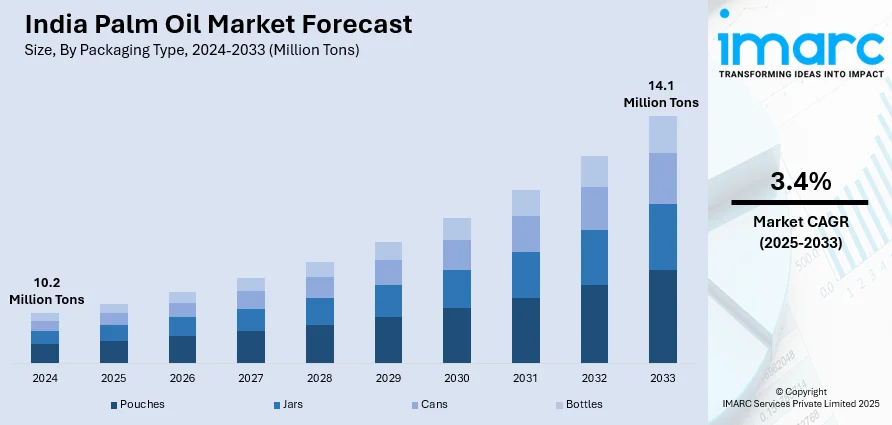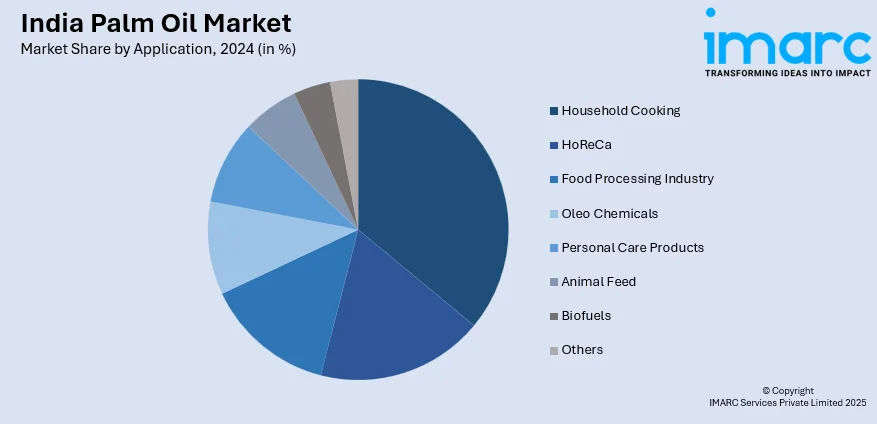
India Palm Oil Market Size, Share, Trends and Forecast by Packaging Type, Packaging Material, Pack Size, Domestic Manufacturing/Imports, Application, Distribution Channel, and Region, 2025-2033
Market Overview:
The India palm oil market size reached 10.2 Million Tons in 2024. Looking forward, IMARC Group expects the market to reach 14.1 Million Tons by 2033, exhibiting a growth rate (CAGR) of 3.4% during 2025-2033.
|
Report Attribute
|
Key Statistics
|
|---|---|
|
Base Year
|
2024
|
|
Forecast Years
|
2025-2033
|
|
Historical Years
|
2019-2024
|
|
Market Size in 2024
|
10.2 Million Tons |
|
Market Forecast in 2033
|
14.1 Million Tons |
| Market Growth Rate 2025-2033 | 3.4% |
Palm oil refers to an edible vegetable oil that is naturally extracted from the mesocarp of palm fruits. Palm oil currently represents the most consumed edible oil in India followed by soybean oil and mustard oil. India’s demand of palm oil, however, is currently met by imports mainly from Malaysia and Indonesia with domestic production being limited. The market for palm oil in India is currently driven by factors such as its lower cost, rising urbanization rates, increasing disposable income levels, rising demand from the food services industry and its increasing applications in the non-food sector.

To get more information of this market, Request Sample
India’s huge population coupled with increasing levels of urbanization and elevating consumer living standards have created a positive impact on the demand of palm oil. Additionally, the rising application of palm oil in processed food items such as bakery products, and confectioneries, is also catalyzing the product demand. India’s fast-growing food service sector which includes hotels, cafes, restaurants, etc. also represents a major driver of the palm oil market in India. Additionally, the rising demand of palm oil in various non-food applications such as surfactants, personal care products, cosmetics, agrochemicals, biofuels, etc. is also driving its demand.
The outbreak of the COVID-19 pandemic, in early 2020, however, has negatively impacted the market for palm oil in India. The national lockdown led to several supply chain disruptions, restricted import activities with palm oil producing nations, and resulted in a temporary shutdown of palm oil processing units. Additionally, the nationwide lockdown also led to a temporary closure of hotels, restaurants, canteens, and public food joints in the country, creating a negative impact on the demand of palm oil.
Key Market Segmentation:
IMARC Group provides an analysis of the key trends in each sub-segment of the India palm oil market report, along with forecasts at the country and regional level from 2025-2033. Our report has categorized the market based on packaging type, packaging material, pack size, domestic manufacturing/imports, application and distribution channel.
Breakup by Packaging Type:
- Pouches
- Jars
- Cans
- Bottles
Breakup by Packaging Material:
- Metal
- Plastic
- Paper
- Others
Breakup by Pack Size:
- Less than 1 Litres
- 1 Litres
- 1 Litres - 5 Litres
- 5 Litres - 10 Litres
- 10 Litres and Above
Breakup by Domestic Manufacturing/Imports:
- Domestic Manufacturing
- Imports
Breakup by Application:

- Household Cooking
- HoReCa
- Food Processing Industry
- Oleo Chemicals
- Personal Care Products
- Animal Feed
- Biofuels
- Others
Breakup by Distribution Channel:
- Direct/Institutional Sales
- Supermarkets and Hypermarkets
- Convenience Stores
- Online
- Others
Breakup by Region:
- North India
- West and Central India
- East India
- South India
Competitive Landscape:
The report provides a comprehensive analysis of the competitive landscape in the India palm oil market with detailed profiles of all major companies, including:
- 3F Industries Ltd.
- AWL Agri Business Ltd
- Emami Agrotech Ltd.
- Gokul Group
- K. S. Oils Limited
- Oil Palm India Ltd.
- Patanjali Foods Ltd.
Report Coverage:
| Report Features | Details |
|---|---|
| Base Year of the Analysis | 2024 |
| Historical Period | 2019-2024 |
| Forecast Period | 2025-2033 |
| Units | Million Tons |
| Segment Coverage | Packaging Type, Packaging Material, Pack Size, Domestic Manufacturing/Imports, Application, Distribution Channel, Region |
| Region Covered | North India, West and Central India, East India, South India |
| Companies Covered | 3F Industries Ltd., AWL Agri Business Ltd, Emami Agrotech Ltd., Gokul Group, K. S. Oils Limited, Oil Palm India Ltd., Patanjali Foods Ltd., etc. |
| Customization Scope | 10% Free Customization |
| Post-Sale Analyst Support | 10-12 Weeks |
| Delivery Format | PDF and Excel through Email (We can also provide the editable version of the report in PPT/Word format on special request) |
Key Questions Answered in This Report
The India palm oil market reached a volume of 10.2 Million Tons in 2024.
The India palm oil market is projected to exhibit a CAGR of 3.4% during 2025-2033, reaching a volume of 14.1 Million Tons by 2033.
The India palm oil market is propelled by stable demand from a growing population, rising incomes, and shifting dietary habits favoring processed and affordable cooking oils. The expanding food processing and HoReCa sector also fuels usage. Government initiatives to boost domestic cultivation and reduce import dependence further support market growth.
The sudden outbreak of the COVID-19 pandemic has led to the changing consumer inclination from conventional brick-and-mortar distribution channels towards online retail platforms for the purchase of palm oil across the nation.
Based on the packaging type, the India palm oil market has been bifurcated into pouches, jars, cans, and bottles. Currently, bottles hold the majority of the total market share.
Based on the packaging material, the India palm oil market can be segmented into metal, plastic, paper, and others. Among these, plastic exhibits a clear dominance in the market.
Based on the pack size, the India palm oil market has been divided into less than 1 litres, 1 litres, 1 litres-5 litres, 5 litres-10 litres, and 10 litres and above. Currently, 1 litres accounts for the largest market share.
Based on the domestic manufacturing/imports, the India palm oil market can be segregated into domestic manufacturing and imports, where imports hold the majority of the total market share.
Based on the application, the India palm oil market has been categorized into household cooking, HoReCa, food processing industry, oleo chemicals, personal care products, animal feed, biofuels, and others. Among these, the food processing industry currently exhibits a clear dominance in the market.
Based on the distribution channel, the India palm oil market can be bifurcated into direct/institutional sales, supermarkets and hypermarkets, convenience stores, online, and others. Currently, direct/institutional sales account for the largest market share.
South India currently dominates the India palm oil market, driven by high consumption in traditional cooking, especially in Kerala and Tamil Nadu, where deep-frying is common. Growing demand from food processing, hospitality, and retail sectors supports expansion. Government initiatives promoting local cultivation in Andhra Pradesh and Telangana also boost regional production and supply.
Some of the major players in the India palm oil market include 3F Industries Ltd., AWL Agri Business Ltd, Emami Agrotech Ltd., Gokul Group, K. S. Oils Limited, Oil Palm India Ltd. and Patanjali Foods Ltd.
Need more help?
- Speak to our experienced analysts for insights on the current market scenarios.
- Include additional segments and countries to customize the report as per your requirement.
- Gain an unparalleled competitive advantage in your domain by understanding how to utilize the report and positively impacting your operations and revenue.
- For further assistance, please connect with our analysts.
 Request Customization
Request Customization
 Speak to an Analyst
Speak to an Analyst
 Request Brochure
Request Brochure
 Inquire Before Buying
Inquire Before Buying




.webp)




.webp)












